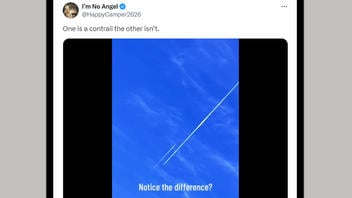
Does a video of two jet aircraft passing in opposite directions show that one is producing a contrail and the other is producing something else -- perhaps a mythical "chemtrail"? No, that's not true: Both planes are producing contrails. The length of the jet's contrail, which consists of mostly water vapor, depends on atmospheric conditions and does not indicate something is being sprayed from the plane. Because safety protocols dictate that two jets flying in opposite directions be vertically separated -- by at least 1,000 feet if flying below 41,000 feet or by 2,000 feet if flying higher than 41,000 feet -- there is enough vertical distance between passing jets for humidity and temperature conditions to differ, which affects how the planes' contrails are formed and dissipate.
The video (archived here) appeared in a response to another post on X. It was published by @HappyCamper2626 on April 4, 2024 with the caption:
One is a contrail the other isn't.
Captioning on the video reads:
Notice the difference?
This is what the post looked like on X at the time of writing:
(Source: X screenshot taken on Fri Apr 5 16:32:06 2024 UTC)
Although this post does not use the word chemtrail, it is clearly implied as this video was shared in response to another post that did use the word chemtrail:
Just then, I started watching airplanes everywhere, crisscrossing across the sky. I watched the Chemtrails in real time and saw the sky get overcast and turn into this fake milky, murky sky.
The word chemtrail is a combination of the words chemical and trail. The term is a misnomer used by conspiracists. The unsupported chemtrail conspiracy theory proposes that there is a large-scale secret plot in which something is being sprayed from planes to achieve an unspecified purpose. Chemtrails are not real, but contrails are. They are a byproduct of jet aircraft traffic, containing mainly water vapor and small particles from aircraft engine exhaust.
In September 2000 the Environmental Protection Agency (EPA), along with NASA, the National Oceanic and Atmospheric Administration and the Federal Aviation Administration, produced a six-page PDF Factsheet (archived here) on aircraft contrails. It explains that if the humidity is low the contrail will be short-lived and how persistent contrails form:
If the humidity is high (greater than that needed for ice condensation to occur), the contrail will be persistent. Newly formed ice particles will continue to grow in size by taking water from the surrounding atmosphere. The resulting line-shaped contrail extends for large distances behind an aircraft (See Figures 2 and 3). Persistent contrails can last for hours while growing to several kilometers in width and 200 to 400 meters in height. Contrails spread because of air turbulence created by the passage of aircraft, differences in wind speed along the flight track, and possibly through effects of solar heating.
On page two of the EPA factsheet, figure 2 (pictured below) shows a scene similar to that in the video -- two contrails that seem to be occupying the same space but with dramatically different appearances. The caption reads:
Figure 2. Photograph of two contrail types. The contrail extending across the image is an evolving persistent contrail. Shown just above it is a short-lived contrail. Short-lived contrails evaporate soon after being formed due to low atmospheric humidity conditions. The persistent contrail shown here was formed at a lower altitude where higher humidity was present Inset: Another example of a short-lived contrail. (Photos: J. Holecek, NOAA Aeronomy Laboratory, Boulder, CO.)
(Source: faa.gov screenshot taken on Fri Apr 05 20:08:07 2024 UTC)
The planes in the video may appear to be dangerously close, but there is a system called the semicircular rule for assigning cruising altitudes. This flight level system is based on odd and even 1,000-foot increments assigned depending on which direction an aircraft is flying. Because the planes in the video are flying in direct opposition to each other we can conclude that they are separated vertically by at least 1,000 feet. At altitudes above 41,000 feet this separation would be at least 2,000 feet.
Additional Lead Stories fact checks about "chemtrails" can be found here.

















